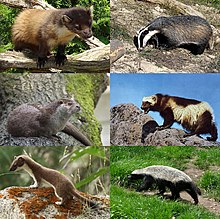
Mustelidae is a family of mammals in the order Carnivora, which includes weasels, badgers, otters, ferrets, martens, minks, and wolverines, and many other extant and extinct genera. A member of this family is called a mustelid; Mustelidae is the largest family in Carnivora, and its extant species are divided into eight subfamilies. They are found on all continents except Antarctica and Australia, and are a diverse family; sizes range, including tails, from the widespread 17 cm (7 in) least weasel to the 1.8-meter (6 ft) giant otter of Amazonian South America. Habitats vary widely as well, from the arboreal marten to the fossorial European badger to the marine sea otter. Population sizes are largely unknown, though two species, the sea mink and Japanese otter, were hunted to extinction in 1894 and 1979, respectively, and several other species are endangered. Some species have been domesticated, e.g. the ferret and some populations of the South American tayra. Mustelidae is one of the oldest families in Carnivora; early mustelids first appeared around 28–33 million years ago.[1]
The 23 genera and 62 extant species of Mustelidae are split into 8 subfamilies: Guloninae, martens and wolverines; Helictidinae, ferret-badgers; Ictonychinae, African polecats and grisons; Lutrinae, otters; Melinae, Eurasian badgers; Mellivorinae, the honey badger; Mustelinae, weasels and minks; and Taxidiinae, the American badger. In addition to the extant subfamilies, Mustelidae includes three extinct subfamilies designated as Leptarctinae, Mustelavinae, and Oligobuninae. Extinct species have also been placed into all of the extant subfamilies besides Helictidinae, in both extant and extinct genera; around 200 extinct Mustelidae species have been found, as well as fossil genera not given a species name, though due to ongoing research and discoveries the exact number and categorization is not fixed.